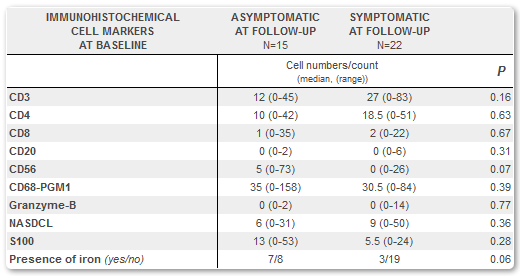Session Information
Session Type: Abstract Submissions (ACR)
Background/Purpose:
In biopsies from non-ruptured chronic tendinopathic Achilles tendons, presence of T and B lymphocytes, natural killer cells and macrophages has been reported. Whether the amount of these cells at baseline is predictive for long term outcome (>3 years) remains to be examined.
The purpose of this study was to evaluate the prognostic value of the amount of immune competent cells present at baseline in biopsies from non-ruptured chronic tendinopathic Achilles tendons.
Methods:
17 women and 20 men suffering from non-ruptured chronic Achilles tendinopathy were followed prospectively for more than 3 years. At baseline, a biopsy was obtained from each tendinopathic Achilles tendon (n=37). In addition to the following immunohistochemical cell markers:CD3, CD4, CD8, CD20, CD56, CD68(PG-M1), Granzyme-B and S100, the biopsies were stained with hematoxylin/eosin, Van Gieson, toluidin blue, Pearls Blue and NASDCL. The numbers/counts (n/c) of positive cells for each marker in each sample were determined and calibrated to a standard area in 4 μm thick slides (equals n/c in standard volume) using unbiased stereological techniques.
At follow-up, patients completed the Scandinavian (Danish) version of the VISA-A questionnaire in addition to a self-composed questionnaire evaluating presence of Achilles tendon symptoms.
The Mann-Whitney rank sum test and the Fishers exact test were used (p<0.05 was considered significant).
Results:
At baseline, the median age of the patients was 55 years (range: 32-69) and the median symptom duration was 12 months (range: 4-156). 18 patients (49%) had never received anti-inflammatory treatment.
Patients were instructed to perform Achilles tendon eccentric loading exercises and were followed for a median time of 6 years (range: 3-11). During this period, the majority of patients (n=31) received additional local tendon injections of steroid (n=12), sclerosis (n=6), TNF-α antagonist (n=6) or interleukin-1 receptor antagonist (n=6). 5 patients had an Achilles tendon operation.
At follow-up, the median VISA-A score was 75 (range: 41-94), and 15 patients (41%) reported having no Achilles tendon symptoms.
No differences in presence of symptoms at follow-up were observed between patients receiving different injection treatments during follow-up (p=0.81).
Conclusion:
37 patients suffering from non-ruptured chronic Achilles tendinopathy were followed for more than 3 years. At follow-up, 15 patients (41%) had no Achilles tendon symptoms. When comparing the asymptomatic group of patients (n=15) to the symptomatic group (n=22), no differences in numbers per count of baseline immune competent cells in standard volume of Achilles tendon biopsies were observed.
Thus, the amount of immune competent cells at baseline cannot predict long term outcome of chronic Achilles tendinopathy.
Disclosure:
M. S. Kragsnæs,
None;
U. Fredberg,
None;
K. Stribolt,
None;
S. G. Kjær,
None;
K. Bendix,
None;
T. Ellingsen,
None.
« Back to 2012 ACR/ARHP Annual Meeting
ACR Meeting Abstracts - https://acrabstracts.org/abstract/is-the-amount-of-t-and-b-lymphocytes-natural-killer-cells-and-macrophages-in-biopsies-from-non-ruptured-chronic-tendinopathic-achilles-tendons-predictive-for-long-term-outcome-a-3-years-p/

